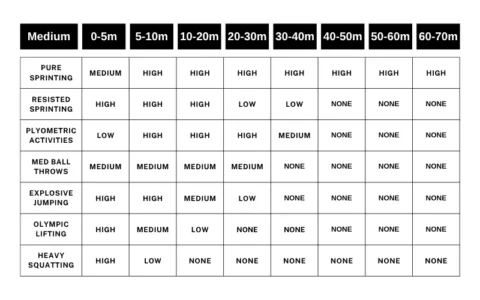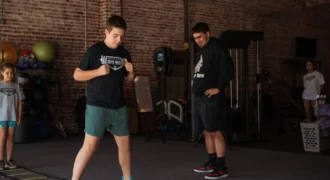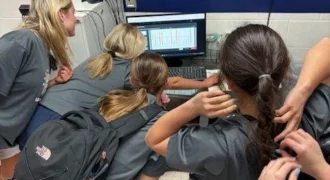Introduction
Velocity driven training has long been a tool now to prescribe intensity ranges for training. These training modalities are typically traditional weightroom barbell lifts such as Squat, Bench, and Deadlift. VBT is a great tool to use for autoregulation, athlete intensity monitoring in set fatigue,and progress the athlete is making at a particular load. These are common uses for VBT and for good reason as they check off many big rocks for a strength and conditioning weight-room program. With that being said, as coaches we are always trying to make the most informed decisions for our athletes. When selecting exercises the goal is to achieve transfer from the training. Yes, some exercises are general in nature like squat, Bench, and Deadlift can be used to develop general qualities like strength, power, and speed. You can get creative as a coach and change the tempo, range of motion, and speed but at the end of the day these exercises are just meant to uplift general qualities. The specificity is what is missing from these lifts. Which is why as coaches when further development is needed we turn to special exercises. The rabbit hole and question I began to ask myself is how specific are these special exercises when it comes to sprint performance?
My answer to these questions was found by being able to use a wearable piece of technology called Output sports. Output sports is a product that I turned to in search of the answers I was looking for. Output has a function that allows you to track angular velocity. If you are unfamiliar with what angular velocity is or more specifically thigh angular velocity I would recommend reading Kenn Clark’s research on it. Moving on, this function was able to give me valuable information on special exercises that we would prescribe to our athletes. Let’s cover some big rocks that I look for when selecting special exercises that could potentially transfer:
- Movement pattern- Does this movement express a similar movement pattern to the desired movement we are trying to support?
- Range of motion- Does this movement express a similar range of movement to the desired movement we are trying to support?
- Velocity of movement- Does the movement express a similar velocity to the desired movement we are trying to support?
- Muscles recruited- Does the movement involve the prime movers involved in the desired movement we are trying to support?
Adding on to that, Vermeil’s chart of transferability in relation to sprinting is certainly something to keep around when thinking of modalities to prescribe to athletes.

Chart: Derived from Vernali’s Chart of Modalities that shows as sprint distance increases, transfer from traditional exercises diminishes. Chart sourced from Science for Sport. (2013, June 10). Kinetics manual [PDF]. Science for Sport. https://www.scienceforsport.com/wp-content/uploads/2018/09/Kinetics-Manual.pdf?srsltid=AfmBOorgPQxpEuG9X5HbfAphhSab9F8k2CoJfS8JAunQqYEy9eZDrHbN
I think as practitioners this is where more specific exercises may be needed to further bridge the gap of specificity. Yes, weightroom ballistic exercises may help improve very early acceleration but they are missing a more specific velocity and range of motion component. Without technology like output I would not be able to get critical information like angular velocity to be specific. Which brings up the next question, what are these exercises that are more specific, and how close are the limb speeds of weightroom based exercises to limb velocities in acceleration?
Why are These Exercises Necessary (Bridging the Gap)
Traditional weight-room exercises typically are designed to improve your ability to produce force. Yes, at times we may choose to do traditional lifts at a higher velocity but these exercises are not close to the same movement patterns of sprinting or velocity sprinting occurs at. A bridge must be created to produce a more specific training environment in terms of movement pattern, range of motion, velocity, and muscles recruited. These exercises are designed around the idea of swing leg retraction, whip from the hip, or pull through. These words are commonly thrown around but all mean the same thing; extension of the hip, knee, and ankle (plantar-flexion) in the late swing phase. The idea is that the limb develops tangential velocity into the ground.

Image: Swing Leg Retraction – Extension of Hip, Knee, and plantar flexion of foot right before touchdown.
Video Description: Speed gallops over hurdles are an excellent drill to get athletes into swing leg retraction. The shin casts out and whips close to underneath the hip. Plantar flexion propels the athlete forward.
This is where I believe many sprint “drills” lose their transferability. Traditional sprint drills such as an A-skip, or upright marching simply teach the leg to strike straight down, which is not what we want to occur in sprinting. Without swing leg retraction, whip from the hip, or pull through we are essentially hitting the brake each step. Film your athletes sprint and you’ll be able to spot the leg just stomping the ground each step.
Video: Example of stomp braking “pushy acceleration”
The athlete will spend a lot of time on the ground, and have to push themselves forward instead of striking the ground and seemingly bouncing forward. Some athletes can get away with this and still sprint fast! But, I’ll bet you they are pretty strong and powerful to accomplish it. Simply put if you watch elite sprinters they can reposition their limb with velocity in an efficient manner that propels them forward. If you have athletes stomping the ground straight down it is time to think about exercises that teach them how to apply force into the ground.
Traditional sprint drills such as an A-skip, or upright marching simply teach the leg to strike straight down, which is not what we want to occur in sprinting, says @_TAPTRAINING
Share on X
Quick Note on Wearable Resistance
I’ll commonly load these exercises with Lila Exogen sleeves as well. I have found that the Exogen sleeves actually help with the coordination of the exercise. The athlete is able to feel where his or her limbs are in space, the load essentially acts as a guide for the athlete. Understand when loading with exogen or any other wearable resistance the further away the load is from the hip the more torque that is generated at the hip. This is known as distal loading. Distal loading is great for training frequency, while loading on the torso is going to train step length. You could probably start to think of athletes you work with that could benefit from either form of loading. Take note that you are adding additional weight onto the athlete, therefore the vertical forces the athlete experiences will be greater. This will challenge stiffness, athletes may experience overly longer ground contact times if the load is too much while sprinting. So be mindful of the amount of load being placed on the athlete. Remember we want sprinting to be an elastic environment, not a long “pushy” struggle. The most I will typically load is 2% BW for a distal load (total load between each limb).
Coordination of not only the limb but stability of the pelvis and torso will be challenged. Arguably stability of the pelvis and torso is just as important as being able to generate limb speed. If the pelvis or torso begins to spill while sprinting, the hips are no longer the driver, projection will be limited and the ability to reposition the limb is also affected. You’ll realize quickly that a lot of athletes will not be able to cycle or swing their limbs in space with intent! Yet, we expect them to be able to do this efficiently while sprinting at speeds around 8 to 10 m/s.
Weight-Room Based Exercises
Below are exercises I will prescribe to develop or support limb velocity.
Video: Athlete Performing the Slice in Place Exercise

Image: Angular Velocity from Continuous slice in place
Coaching Cues:
- Athletes will lift a slightly bent knee leg (almost straight) as high as they can, while maintaining a neutral pelvis.
- Instruct the athlete to accelerate or “pull” the limb down into extension at the hip, and then “rip” the leg back up into the initial position.
- Make sure the torso maintains a steady position throughout the exercise.
- The pelvis should be neutral throughout the exercise.
- The athlete should be on the ball of their foot throughout the entire exercise 6. If the athlete struggles coordinating the movement, move to single repetitions instead of continuous repetitions.
Video: Athlete Performing the Acceleration Piston Swing Exercise

Image: Angular Velocity of Continuous Acceleration Piston Swing
Coaching Cues:
- The athlete should align themselves at a 45 Degree (acceleration like position) on the balls of their feet.
- The athlete will lift one leg into hip flexion and then “pull” through into extension, and then “rip” back into flexion.
- The pelvis should remain neutral and the torso should stay steady throughout movement.
- If the athlete struggles coordinating the movement, move to single repetitions instead of continuous repetitions.
Video: Athlete Performing the Upright Cycle B Exercise

Video: Angular Velocity of Upright Cycle B Exercise
Coaching Cues:
- The athlete should start in an upright position with the hip in flexion.
- Instruct the athlete to “pull” through, release and extend at the knee 3. The athlete should bring the calf to the hamstring during the backside swing portion of the exercise.
- The pelvis should remain neutral and the torso should stay steady throughout movement.
- If the athlete struggles coordinating the movement, move to single repetitions instead of continuous repetitions.
Video: Athlete performing Frans Bosch Step Down Switch drill

Image: Angular Velocity of Frans Bosch Step Down Switch
Coaching Cues:
- The athlete will start with one leg on a 3-6 inch box. The other leg is in hip flexion. 2. Encourage the athlete to simultaneously pull the leg in hip flexion into extension, while ripping the leg on the box from extension into flexion.
- We want the athlete to respond off of the ground quickly and “rip” the leg back into flexion.
- The pelvis should remain neutral and the torso should stay steady throughout movement.
Video: Athlete Performing Single Leg Sprints on the SHREDmill

Image: Angular Velocity of Single Leg SHREDmill Sprint
Coaching cues:
1. The athlete will begin to jog on the SHREDmill to get the belt started.
2. The athlete will then transition to a single leg and begin a single sprint cycle action.
3. Encourage the athlete to have some forward lean with their torso.
4. Encourage the athlete to pull the calf to the hamstring on the backside portion of the exercise.
Understand that the angular velocities will vary depending on a couple of factors, such as:
1. Proficiency of ability to perform the exercise.
2. Ability level of the athlete. For example, a faster athlete will have a faster thigh angular velocity during sprinting. They will also perform these exercises at a higher speed. Below is a difference in the angular velocities during 10 build 10 fly between myself and the athlete shown on the single leg sprint who is a track and field athlete.
Disclaimer– All data on exercises are from myself except for Single Leg Shred Sprint.


Image: Difference in angular velocities between myself and a track athlete. Inability to properly to reposition limb drives down limb speed. As you can see the differences between the consistency in angular velocity between myself and the track athlete.
Closing Thoughts
Are these exercises alone going to sky rocket your speed instantly? No. There is no singular exercise that will make you faster instantly. What these exercises can do is hone in on key performance indicators that we look for in sprinting (swing leg retraction), provide a stressful stimulus from an angular velocity perspective, and teach pelvis and torso control. Will the speeds be close to angular velocities found in acceleration? My answer to that question is yes. An interesting find is what is occurring on the SHREDmill. We are finding that when the SHREDmill is at a light resistance (Gear 3 resistances) limb speed is greater than on the ground during accelerations (for technically proficient athletes). Now reasons for this could be offloading of body weight by holding on during the gait cycle on the SHREDmill, and the inertial differences between the ground and a moving belt. Nonetheless, I still believe the value is certainly there. It can surely be used as a tool to develop limb speed and expose the limbs to high velocities.

Image: Angular Velocity of Gear 3 Rep Acceleration of Track Athlete
As stated earlier, is it the end all be all…no, a well thought out program that attacks weaknesses and uplifts strengths must be applied to get faster, not just a couple of exercises. Remember if you want to get faster you must sprint. These exercises are here to attack weaknesses and support speed training bridging the gap of specificity.
How often and where would I fit these into an athlete’s training? I think these exercises could be an excellent way to start off or end a speed session. For example, using these exercises in a sprint preparatory block before high speed sprinting is a great way to include these movements. Start with the continuous slice, or upright cycle to learn the coordination in a stationary position while keeping the torso and pelvis in a stable position. Then transition into a primetime or gallop to apply the movement pattern in a dynamic environment. Another potential way to program these exercises is during the lift. An athlete could start with their primary strength movement (Trap Bar Deadlift), perform their plyometric, and then finish with a specific limb speed focused exercise. Performing these exercises for 6 to 10 seconds or 10-15 reps for 3-4 sets 2-3 times a week is a great place to start. More is not always better. Provide a stimulus and allow for recovery to receive the adaptation!
More is not always better. Provide a stimulus and allow for recovery to receive the adaptation! – says @_TAPTRAINING
Share on X
The post Bridging the Gap – How Training Angular Velocities in the Weight Room Transfers to Sprinting appeared first on SimpliFaster.







